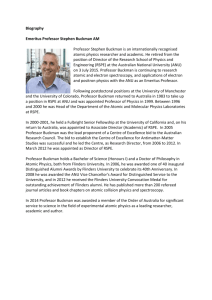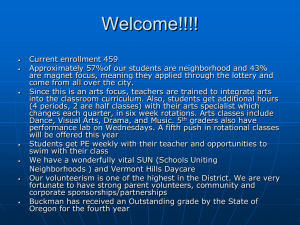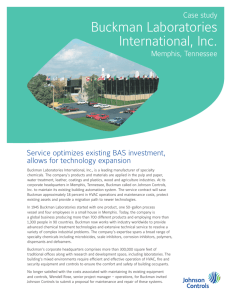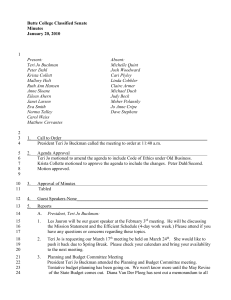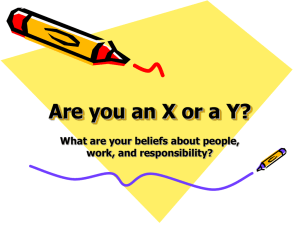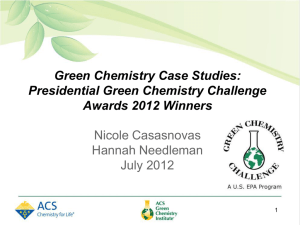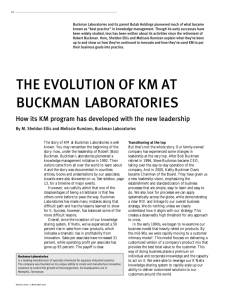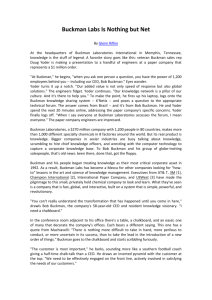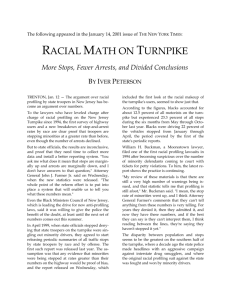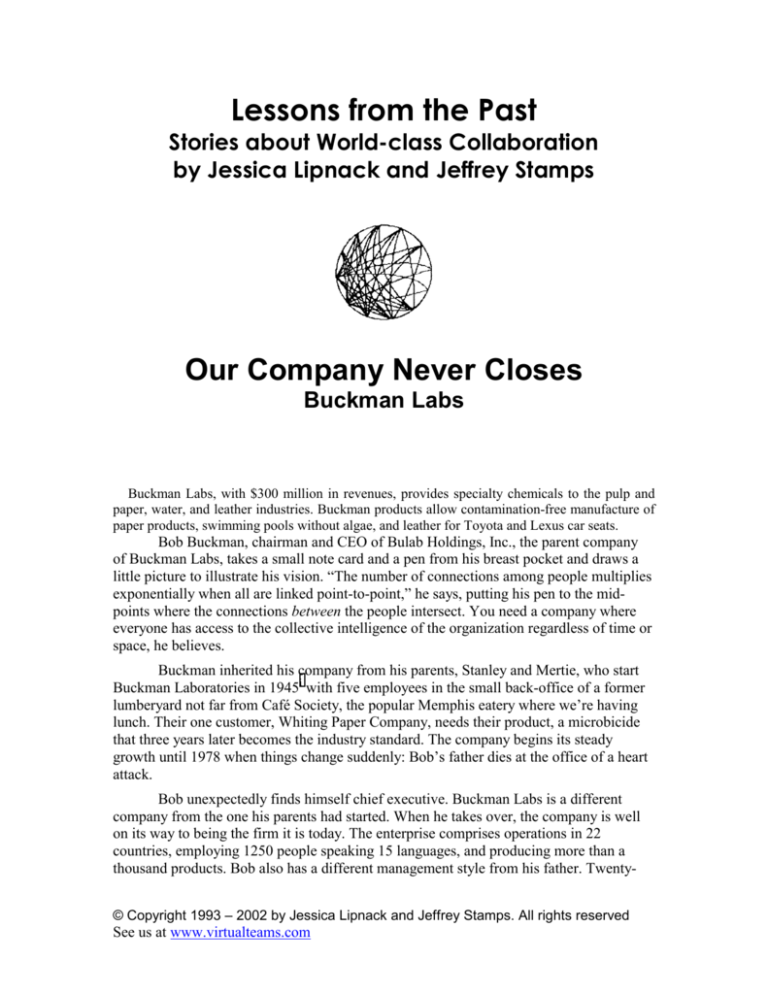
Lessons from the Past
Stories about World-class Collaboration
by Jessica Lipnack and Jeffrey Stamps
Our Company Never Closes
Buckman Labs
Buckman Labs, with $300 million in revenues, provides specialty chemicals to the pulp and
paper, water, and leather industries. Buckman products allow contamination-free manufacture of
paper products, swimming pools without algae, and leather for Toyota and Lexus car seats.
Bob Buckman, chairman and CEO of Bulab Holdings, Inc., the parent company
of Buckman Labs, takes a small note card and a pen from his breast pocket and draws a
little picture to illustrate his vision. “The number of connections among people multiplies
exponentially when all are linked point-to-point,” he says, putting his pen to the midpoints where the connections between the people intersect. You need a company where
everyone has access to the collective intelligence of the organization regardless of time or
space, he believes.
Buckman inherited his company from his parents, Stanley and Mertie, who start
Buckman Laboratories in 1945i with five employees in the small back-office of a former
lumberyard not far from Café Society, the popular Memphis eatery where we’re having
lunch. Their one customer, Whiting Paper Company, needs their product, a microbicide
that three years later becomes the industry standard. The company begins its steady
growth until 1978 when things change suddenly: Bob’s father dies at the office of a heart
attack.
Bob unexpectedly finds himself chief executive. Buckman Labs is a different
company from the one his parents had started. When he takes over, the company is well
on its way to being the firm it is today. The enterprise comprises operations in 22
countries, employing 1250 people speaking 15 languages, and producing more than a
thousand products. Bob also has a different management style from his father. Twenty© Copyright 1993 – 2002 by Jessica Lipnack and Jeffrey Stamps. All rights reserved
See us at www.virtualteams.com
Great Collaboration Stories - Buckman
2
six people reported directly to “Dr. Stanley,” an unworkable structure in his son’s
estimation. So from his earliest days, “Bob” works to create a less bureaucratic, more
responsive, and very intelligent organization.
In his speeches, Buckman refers to 1984 as the starting point for his company’s
“journey—it’s not a project,” he saysii. That year he meets the author, Tom Peters, whose
1983 best-seller, In Search of Excellence, co-authored with Robert Waterman,
revolutionizes how people look at their businesses (and breaks open the business-book
industry). Buckman is among the first to attend Peters’ Skunkcamp, designed by Reuben
Harris,iii Peters’ then-partner (the two had met as doctoral students at Stanford Graduate
Business School), a week-long intensive on unconventional business ideas. Buckman
eventually sends most of his senior management to the program.
Fate intervenes again in 1989 when Buckman ruptures a disk that lays him flat on
his back for several weeks. His mind has been on high-churn since meeting Peters and
Harris who joins the Buckman board of directors, and he has been experimenting. But
when he finds himself unable to even sit up, he realizes that if he can’t get to his office,
he is completely cut off from work. He wonders: “Why do organizations spend huge
sums of money on systems that only function 14 percent of the time?” He not only
characterizes the lives of his executives, managers, and people in sales but also
anticipates changes ahead.
Buckman comes up with the idea that fits his immediate need and will catalyze
the redesign of the company.
He decides to put everyone online.
His experiment proves so successful that everyone from Peters himself to Fast
Company to Harvard Business School has written about it. HBS’s case study describes
Buckman’s mission this way: “If he could connect people through a network, he could
‘replace the depth of knowledge offered in a multi-tier hierarchy with the breadth of
knowledge that is the sum of the collective experience of employees.’”iv
In 1989, before the general commercial availability of the Internet, K’Netix is
born, an online network that allows everyone in the company to talk to everyone else
anywhere at any time. In a pre-web era, it's a major challenge to get thousands of people
around the world comfortable with logging in every day to solicit and contribute advice
to people they rarely if ever see.
The impetus for K’Netix is the desire to share best practices for solving customer
problems. “We couldn’t run Ph.Ds around the world fast enough at the speed that we
needed,” Buckman recalls. How did he do it? Buckman offered these thoughts on
successful implementation from his 21st century hindsight:
•
Technology. Everyone in the global Buckman has access to PCs and laptops. When they
travel, they can take “electronic first aid” kits with them, equipped with whatever they will
need for where they’re going (telephone connectors, adapters, and cables).
Great Collaboration Stories - Buckman
3
•
Free, unrestricted access to the Internet. “We say, ‘Go play, go learn.’ People have to learn
how to be comfortable with technology,” he says.
•
Coaching and facilitation. For the first several years, coaches regularly spent 12 hours a day
online just helping people become comfortable. Today, every online discussion area has its
own moderator, many of whom have gone on to invent their own ways of working online.
•
Culture change. “It’s 90 percent culture change and 10 percent technology,” he says. “It’s
people who bring about the change.”
Alison Tucker, now director of Global Media and Promotions for Buckman, is the company’s
original online coach and over the years has participated in each online innovation.
She says she spent “endless amounts of time online. I was learning to manage all
these crazy discussions. When we started out, half the things going on were not business
related—people talking about their kids and their dogs. We’ve always been this global
company, but people didn’t have a chance to talk until this happened. We’d have chat
sessions [real-time, online text exchanges] at 5:30 or 6:00 PM Memphis time with people
saying, ‘I have to go answer the phone or door.’ People in Japan were telling jokes to
people in Brazil.”
“Our use was very high at the beginning while everyone was learning and now
it’s leveled out,” Tucker says. “The key thing is to be patient and advertise, advertise,
advertise to your people. We didn’t have anybody to learn from. And we still don’t, but
we’re learning from each other.”
The initial getting-to-know-one-another frenzy lasts for about three months when
things begin to settle down into scientific and business conversations.
To encourage company-wide participation, Buckman himself takes to the world
circuit. He gives speeches on the role of knowledge transfer and his belief that the
company’s intelligence lies “between the ears of the people, not in some database.” From
the beginning, he is an active daily participant. “It has to have unequivocal leadership at
the top,” he says.
For the first six months of K’Netix, they run weekly reports to see who is
participating and who is not. Every Friday morning, everyone in the company receives a
report via e-mail listing the people who have not logged in by the previous afternoon.
Buckman himself sends messages to these people asking why they aren't online and if
they need any help. The desire to be absent from the list is so strong that they only need
to run the reports for six months.
Soon people are participating in dozens of knowledge-sharing meetings online.
Customer problems that once took days to resolve can be answered in a few hours.
By today’s stupefying technology standards, the Buckman Global Knowledge
Network is—and remains—pretty elementary. After their first five years using a
cumbersome IBM network that requires different codes for different countries, they move
to CompuServe in 1992.
“We chose CompuServe because of ease of use,” explains Tucker. It offers local
dial-in numbers in all the countries where Buckman has operations. While other
Great Collaboration Stories - Buckman
4
companies developed complex groupware and knowledge-management systems,
Buckman chooses instead to outsource and buy retail. (“The only reason companies
create their own systems today is ego!” Buckman says emphatically.)
CompuServe, now part of its once-arch rival America Online, also offers simple
software for online discussions called “forums.” Each forum is on a separate topic and
any authorized person can read and post messages. Because it captures everything
electronically, the system maintains its own ongoing discussion history that can track
decision-making and problem-solving. Buckman has numerous forums on topics germane
to its business, including everything from customers to strategy to new product
development. The forums are portable; when Buckman switches platforms again to
Internet news-groups the forum topics continue.
From Drums to Advice
Steve (Bob’s cousin) Buckman, now the Buckman Labs’ CEO, recalls how
different customers are today from the past. “Fifteen years ago, they said, ‘If you don't
make it, why are we talking to you?’ Now they say, ‘We know you don't make it but go
find it, buy it, and make it work.’ We're really an intermediary.”
Buckman Labs’ customer, SAPPI, an Italian pressmaker early to automation, is
planning a new system to bring out a new grade of paper in South Africa. “They sent a
simple e-mail with their query and they got back 10 articles on how to do it. They were
just amazed we would do this for them. Customers want us as consultants on how to
solve their problems, but they also want us to bring in the product. We don't want to
have to go three different places to solve the problem, procure the chemicals, and
implement it in their production system,” Steve Buckman explains.
So the company’s business model is maturing. As products become commodities,
a company like Buckman “just can’t pump things out quickly enough. We’re all selling
the same kinds of chemistry,” says Sheldon Ellis, director of Bulab Learning Center.
Today Buckman is also a service company where knowledge is the capital. “We actually
can make more money solving problems and handling processes for customers than
shipping drums [of chemicals] alone,” Ellis says.v
In 1996, Bob Buckman asks Ellis to pull together a plan for the Bulab Learning
Center, where all the company’s knowledge, training, communication—and of course
K’Netix—will have a home. “Bob said he wanted the Learning Center operational in a
month,” Ellis recalls. “I went to two folks from IT with business skills and said, ‘I’m
asking you to leave what you’re doing and get on the ride of your life. This will be the
coolest thing you’ve ever done.’”
“We built the architecture then plugged in everything we could find. I was reading
how to do [Lotus] Notes development on a tour bus in Mexico, and my modem burned
out, so I had to have a new one Fedexed. We worked day and night and threw a lot of
things together very, very quickly.” Three-and-a-half weeks later, Bulabs Learning
Center is operational with 75 courses available online.
Today the Learning Center employs 10 people from Asia, South America, and the
U.S. who speak 11 languages and come from a variety of specialties: a chemical
Great Collaboration Stories - Buckman
5
engineer, an agronomist, a computer scientist, a paper-making scientist, a political
scientist, and a Spanish linguist. Among their many ambitions is one to make the site
fully accessible in the company’s four principal tongues—English, Spanish, Portuguese,
and German. “There aren’t many others trying to do a multi-lingual, academic, technical,
personal/professional, career-development, learning- center web site,” Ellis says.
They offer “knowledge” in many media, including traditional face-to-face courses
with hardcopy (they call it “stand up”). The Learning Center produces thousands of CDs,
offers 500 online courses through partnerships with 20 universities, stores countless
presentations and documents, and is developing new ideas by the day. “We’re constantly
taking things up and down,” as Ellis puts it, regularly trying things out on the site.
“Philosophically we’re going to more contextual learning,” Ellis says. “Instead of long
classes, we’re developing just-in-the-nick-of-time learning nuggets around what people need to
know.” They’re also setting up communities of practice, that offer, for example, the group of
microbiologists across the company “a voice and a platform and mechanism to be able to build”
the tools they need. “We’re creating virtual places for people to learn.”
The Culture Shop
Edson Peredo, the company’s president and a Brazilian who ran operations there
for many years, describes himself as “not a fancy user but a frequent user.” Peredo
believes that cultural barriers “will be there for years to come” preventing people from
using technology to its greatest advantage. “Most of my people still prefer face-to-face or
at least a phone call. Perhaps this is due to the degree of trust and sensitivity about
information that goes across the table or phone line. But as far as transferring
information, I wouldn’t give that up for anything,” he says citing how he just downloaded
a 45-page document. “Next week someone will be asking me about that specific
document and I can say. ‘Yes, I’ve seen it,’ and that’s how it benefits my work.”
And just the month before, he calls on a customer in California whom he has been
e-mailing. “I felt like I’d been there before, I know these people and we’re not strangers
to each other. We exchange notes and pictures over the Internet, and you quickly find
commonalities between you and your customers. Without our culture, that would not be
possible. You would have to sit down for days to have the same relationship.”vi
Mark Koskiniemi, vice president of Human Resources at Buckman Labs, is
thinking ahead about how to expand learning in the organization. “We can do it by hiring
the latest and greatest graduates. But then what? That led us to distance learning and
distributed learning that really have for the first time knocked down the socio-economic
barriers to education. We’ve leveled the playing field from Singapore to South Africa.
The next step is for our associates to continue to grow and learn and educate themselves,
then to refresh our education for ourselves and our children. You never know where the
new knowledge is going to come from. The Bulab Learning Center has been created to
fill the gap.”
“There’s a really important ‘watch out for.’ Don’t expect the technology to do it
all itself,” Koskiniemi says. “It’s culture, culture, culture. Top management has to
support it; they lead by example. Bob is pushing the frontier with tools that we’re
Great Collaboration Stories - Buckman
6
providing. People who can use the tools get promoted. You don’t need to bankrupt
yourself on technology.”
Customer Benefits
Although he is a chemist and a statistician (undergraduate degree from Purdue
University in chemical engineering and an MBA from the University of Chicago),
Buckman sounds at times like a communications theorist. For people to be effective,
Buckman says, they need information that increases their “span of communication” and
thus their “span of influence.”1
“The speed at which you can communicate defines how quickly you can make
money,” Buckman says. “If I can respond to a customer in six hours anywhere in the
world at any time, that’s a competitive advantage. As the speed of communication
increases, customer response time moves toward instantaneity [a Buckmanism]. That
redefines competition. Any entrepreneur in the world will understand that.”
Buckman says that to unleash the power of the individual, everyone has to
“radically change their span of communication and I mean radically. Anyone should be
able to talk to anyone else inside and outside the organization. We want to close the gap
with the customer. How do we increase our cash flow with the customer? By increasing
our power on the front line. But that can only happen if the individual has good span of
communication.”
Buckman’s goal is to have 80 percent of the company “effectively engaged on the
front line,” that is, directly connected with customer needs. “If you’re not doing
something useful for a customer, why are you here?” He only has a few percentage points
to go before having quintupled the number from 16 percent in 1979.
A company like Buckman is the latest in a long line of innovations centered on
small groups working together. As a species, we’ve been working on this form of
organization for a long time.
Great Collaboration Stories - Buckman
i
7
Ironically, the year we date the "birth" of the Information Age (see Chapter 2).
“The Power of Collaborative Knowledge,” speech by Robert H. Buckman, delivered at
“Lessons from the Front: Putting Knowledge Sharing to Work, seminar, U.S.
Department of Defense, General Pershing room, July 28, 1999 [mention AKG and/or
NetAge in footnote?]
ii
iii
Harris is now …
iv
“Buckman Laboratories (A), ©Harvard Business School, N9-899-175, Rev.
September 17, 1999, p. 5. [Contact our friends at HBS Press—Loren, Anne Briggs and
ask them how to get permission – it says we need it even to quote a sentence on the
original; Bob B gave this to me]
Interview with Sheldon Ellis, director, Bulabs Learning Center, Memphis, TN,
October 7, 1999.
v
vi
Interview with Edson Peredo, Buckman Labs, Memphis, TN, October 8, 1999.

